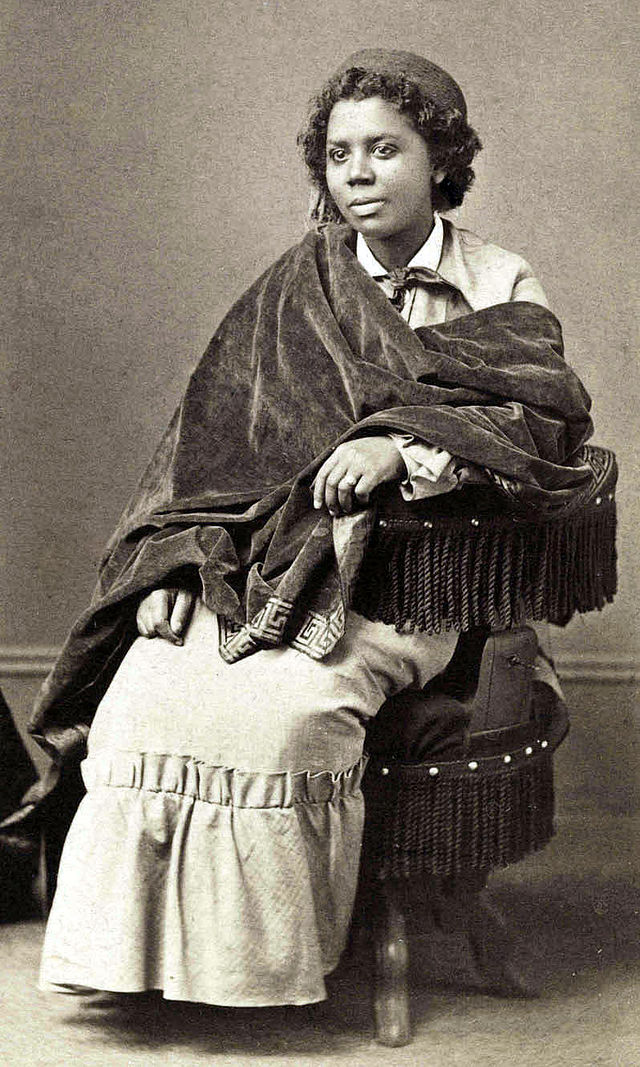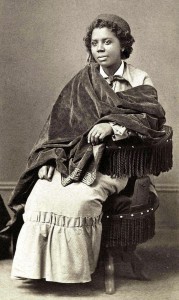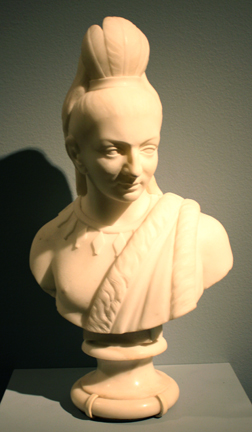
This week’s open thread topic will focus on highlighting some notable Black Indians.
Edmonia Lewis (ca. July 4, 1844 – September 17, 1907) was an African American sculptor who worked for most of her career inRome. She gained fame and recognition as a sculptor in the international fine arts world. In 2002, the scholar Molefi Kete Asantelisted Edmonia Lewis on his list of 100 Greatest African Americans.
Edmonia Lewis was born on July 4, 1844, in Greenbush, New York, which is now the city of Rensselaer. Her father was Haitian of African descent, while her mother was of Mississauga Ojibwe and African-American descent. Lewis’s mother was known as an excellent weaver and craftswoman, while her father was a gentleman’s servant. Her family background inspired Lewis in her later work.
When Lewis was about nine years old, both of her parents died within a year of each other. Lewis and her older brother, Samuel, were taken in and lived with their mother’s sisters for the next three years. Lewis and her aunts sold Ojibwe baskets and other crafts to tourists visiting Niagara Falls, Toronto, and Buffalo. During this time, Lewis went by her Native American name, Wildfire, while her brother was called Sunrise. Becoming a successful businessman and gold prospector, her brother Samuel paid for her tuition to theNew York Central College. Lewis was rebellious and did not learn English well, so Samuel suggested she transfer to Oberlin College, outside Cleveland, Ohio, where she changed her name to Mary Edmonia Lewis.
At the time, Oberlin College was one of the first higher learning institutions in the United States to admit women and people of differing ethnicities. Lewis’s decision to attend Oberlin was one that would significantly change her life, as that is where she began her art studies.
During the winter season of 1862, several months after the start of the Civil War, while Edmonia Lewis attended Oberlin College, an incident involved her and two classmates, Maria Miles and Christina Ennes. The three women, who boarded in the home of Oberlin trustee John Keep, planned to go sleigh riding with some young men later that day. Before the sleighing, Lewis served her friends a drink of spiced wine. Shortly after, Miles and Ennes fell severely ill. Doctors examined them and concluded that the two women had some sort of poison in their system, apparently cantharides, a reputed aphrodisiac. For a time it was not certain that they would survive. Days later, it became apparent that the two women would recover from the incident, and, because of their recovery, the authorities initially took no action.
Townspeople attacked Lewis. While she was walking home alone one night, she was dragged into an open field by unknown assailants and badly beaten. Those responsible for her injuries were never found. Due to the attack, local authorities arrested Lewis, charging her with poisoning her friends. The college defended their student throughout the trial. John Mercer Langston, an Oberlin College alumnus, and the only practicing African-American lawyer in Oberlin, represented Lewis during her trial. Although most witnesses spoke against her and she did not testify, the jury acquitted her of the charges.
After college, Lewis moved to Boston late in 1863. She began to study under a well-known sculptor, Edward Augustus Brackett. Under his tutelage, she crafted her own sculpting tools and sold her first piece, a sculpture of a woman’s hand, for $8. She opened her studio to the public in her first solo exhibition in 1864.
Lewis was inspired by the lives of abolitionists and Civil War heroes. She met Union Colonel Robert Gould Shaw, the commander of anAfrican American Civil War regiment from Massachusetts. She was inspired to create a bust of his likeness, which impressed the Shaw family, who purchased her homage. The poet Anna Quincy Waterston was inspired to write a poem about both Lewis and Shaw.
Early works that proved highly popular included medallion portraits of the abolitionists John Brown and William Lloyd Garrison. Lewis also drew inspiration from Henry Wadsworth Longfellow and his work, particularly his epic poem, The Song of Hiawatha. She made several busts of its leading characters, for which he drew from Ojibwe legend.
The success and popularity of these works in Boston allowed Lewis to bear the cost of a trip to Rome in 1865. On her 1865 passport is written, “M. Edmonia Lewis is a Black girl sent by subscription to Italy having displayed great talents as a sculptor”. The established sculptor Hiram Powers gave her space to work in his studio. She entered a circle of expatriate artists and established her own space within the former studio of 18th-century Italian sculptor Antonio Canova.
Rome was where Lewis spent most of her adult career. Her studies there contributed to herneoclassical techniques and subject matter. The surroundings of the classical world greatly inspired her and influenced her work. She recreated the classical art style in her own work. For instance, she presented people in her sculptures as draped in robes rather than in contemporary clothing.
A major coup in her career was participating in the 1876 Centennial Exposition in Philadelphia. For this, she created a monumental 3,015-pound marble sculpture, The Death of Cleopatra, which portrayed the queen in the throes of death. Of the piece, J. S. Ingraham wrote that Cleopatra was “the most remarkable piece of sculpture in the American section” of the Exposition. Much of the viewing public was shocked by Lewis’s frank portrayal of death, but the statue drew thousands of viewers. After being placed in storage, the statue was lost, not to be found again until a century later in the mid-1980’s in Chicago. According to George Gurney, Curator Emeritus at the Smithsonian American Art Museum, the sculpture was in a race track in Forest Park, Illinois, during World War II, sitting on top of the grave of a horse named Cleopatra. The grounds later turned into military housing and was used for children’s games before becoming a shopping mall, when the sculpture was moved to the work yard of one of the developers of the mall. At some point during this time, the Italian marble was painted over by a troop of well-meaning Boy Scouts. Finally, the sculpture became under the purview of the Forest Park Historical Society, who donated it to Smithsonian American Art Museum in 1994, where conservators restored it to its near-original state.
A testament to Lewis’s renown as an artist came in 1877, when former US President Ulysses S. Grant commissioned her to do his portrait. He sat for her as a model and was pleased with her finished piece.
In the late 1880’s, the neoclassical genre became less popular, and Lewis’s popularity also declined. She continued to work in marble, increasingly creating altarpieces and other works for Roman Catholic patrons. In the art world, she became eclipsed by history and lost fame. The events of her later years are not known.
Lewis never married and had no known children. Her brother Samuel became a barber in San Francisco, eventually moving to mining camps in Idaho and Montana. In 1868, he settled in the city of Bozeman, where he set up a barber shop on Main Street. He prospered, eventually investing in commercial real estate, and subsequently built his own home which still stands at 308 South Bozeman Avenue. In 1999 the Samuel Lewis House was placed on the National Register of Historic Places. In 1884, he married Mrs. Melissa Railey Bruce, a widow with six children; they had one son, Samuel E. Lewis (1886–1914), who married but died childless. The elder Lewis died after “a short illness” in 1896 and is buried in Sunset Hills Cemetery in Bozeman.
For years, the year of Edmonia Lewis’s death was speculated to be 1911 in Rome. An alternative view held that she died in Marin County, California, and was buried in an unmarked grave in San Francisco. Recent scholarship has found that she lived in the Hammersmith area of London, England before her death on September 17, 1907, in the Hammersmith Borough Infirmary.



